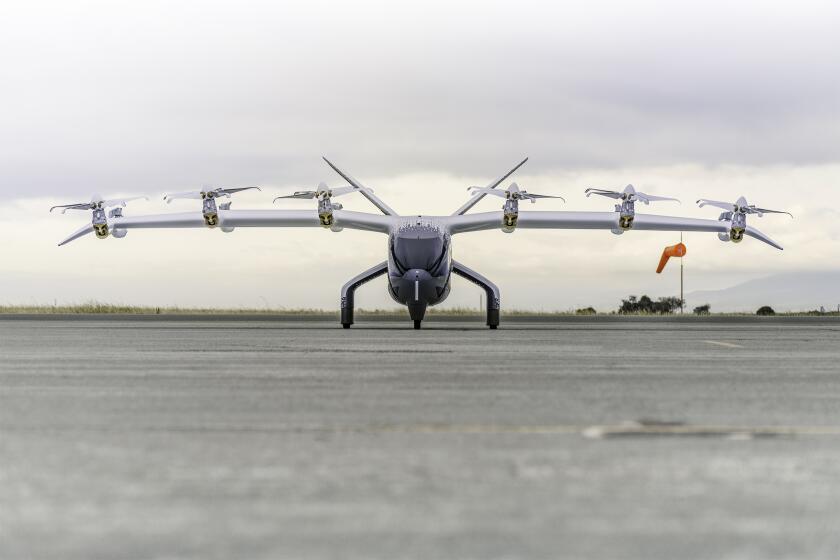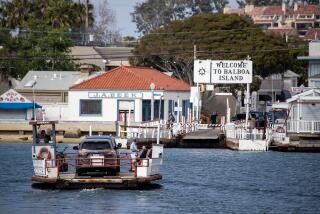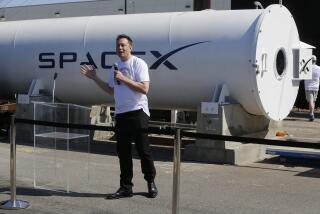A ‘flying’ electric ferry could get visitors across Lake Tahoe in 30 minutes

- Share via
Lake Tahoe visitors and locals may one day be able to avoid the area’s congested and winding roads and opt instead to glide across the lake on a “flying” electric ferry.
FlyTahoe and Sweden-based Candela are working to build this type of electric vessel in the U.S., which would get a boost above the water via hydrofoiling — a technology used in water sports on surfboards, jet skis and racing yachts — that relies on underwater wings to lift the hull above the waves.
The ferry would cater to Lake Tahoe’s California side and shuttle 30 passengers at a time across the roughly 20-mile stretch between the north and south ends of the lake. The 30-minute one-way ride would be a significant time-saver on a trip that can take two hours in a car.
“This is solving a critical transportation problem around the entire Tahoe basin,” said FlyTahoe founder and Chief Executive Ryan Meinzer, who said the ferry could be in operation by late 2025 or early 2026.
A report from the Tahoe Transportation District in 2012 identified a north-south ferry service as a solution to reduce traffic in Lake Tahoe and enhance the public transit system. Despite an initial analysis of a large passenger diesel fuel-powered ferry, the option has not been developed. The area gets millions of annual visitors and Meinzer says it is time to make an electric ferry system a reality, reducing traffic and emissions.
District Manager Carl Hasty said that he has not connected with FlyTahoe or Candela but that he believes the ferry could benefit the area, if it could meet all the regulations related to permitting and infrastructure.
“If you want to get from one end of the basin to the other, it can be difficult. In summer, you can have construction congestion. You can have congestion just from the volume of cars that are largely on a two-lane highway system. In the winter time, you add snow,” Hasty said.
“I think it has a role to play.”
Tahoe is home to multiple resorts on the north and south side of the lake, but residents and tourists who want to visit one area from the other have a long commute. Meinzer’s interest in finding a faster alternative stemmed from his own snowboarding experiences when he’d visit the area and wade through traffic, wondering why there wasn’t a more seamless route. He was aware of hydrofoils for surfing and wakeboarding, and eventually learned about Candela’s efforts.
Archer Aviation announces plans for a 2026 launch in Los Angeles ahead of the World Cup and the 2028 Olympics.
The hydrofoil technology, which allows for a smoother ride above waves, has been around for decades and has continued to emerge on a larger scale as electric power has gained traction. Candela launched a ferry in Stockholm this year that uses a hydrofoil system suited for electrification.
“It basically works like a jet fighter … except our wings fly in water instead of air,” Candela founder and CEO Gustav Hasselskog said in a statement.
A Washington state transit agency is working on its own hydrofoil electric ferry design in Puget Sound.
The passenger vessel in Lake Tahoe initially would accommodate roughly 300 people a day over multiple rides. Meinzer envisions a future fleet that could shuttle more passengers and improve accessibility.
Aside from building the vessel, which federal maritime law requires to be constructed in the U.S., several other steps must be taken before a launch. FlyTahoe would need to work with the private and public marinas around the lake to ensure there’s proper infrastructure to charge the electric ferry, which Meinzer said could make a round trip when fully charged. The company also would have to follow various regulatory requirements related to permitting, design and shoreline effect and work with local, state and federal agencies, including the U.S. Coast Guard, which has authority on the lake.
“We want to make sure we’re solving this transit problem while keeping the pristine beauty of this lake,” Meinzer said.
Visitor parking would need to be established for those who plan to ride the ferry, which could accommodate bicycles but not cars.
Meinzer did not disclose the budget needed to produce the flying electric ferry but said a one-way ticket would initially cost about $50.
More to Read
Sign up for Essential California
The most important California stories and recommendations in your inbox every morning.
You may occasionally receive promotional content from the Los Angeles Times.












